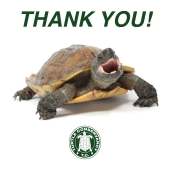
 11
11




 10
10




 The drawbacks to it are getting wet when I walk thru the yard, and the millions of wood ticks that love the deep grass. I don't have much to add, but please keep posting if you come up with new methods. I have run over way too many snakes and toads and I'm not willing to do it anymore.
The drawbacks to it are getting wet when I walk thru the yard, and the millions of wood ticks that love the deep grass. I don't have much to add, but please keep posting if you come up with new methods. I have run over way too many snakes and toads and I'm not willing to do it anymore."People may doubt what you say, but they will believe what you do."
 9
9




With forty shades of green, it's hard to be blue.
Garg 'nuair dhùisgear! Virtutis Gloria Merces
 6
6




Karen Layne wrote:.
On our gravel road, I drive home at night sometimes, where the neighbors may think I'm drunk, but I'm just trying to dodge the frogs in the road.
 We have many more toads than frogs. Anytime it is raining out, I stop and pick the toads up out of the road and bring them home. I have many happy toads living at my house.
We have many more toads than frogs. Anytime it is raining out, I stop and pick the toads up out of the road and bring them home. I have many happy toads living at my house."People may doubt what you say, but they will believe what you do."
 8
8




Idle dreamer
 3
3




 Oh btw, when there are not many bugs, frogs go away too.
Oh btw, when there are not many bugs, frogs go away too. 2
2




 Thank you for sharing that.
Thank you for sharing that."People may doubt what you say, but they will believe what you do."
 3
3




 2
2




Todd Parr wrote:I am doing everything I can to attract all the things that you say coffee grounds will drive away. I'm glad I know that coffee grounds do that so I make sure I mix them into my compost bins rather than spreading them
Thank you for sharing that.
 2
2




s. ayalp wrote:
Speaking of mob grazing, does anyone know what happens to all those little creatures when the pasture is mob grazed? How they run away? I wouldn't want to be one of those toads for sure.
Idle dreamer
 3
3




 2
2




 5
5





 7
7




 6
6




Christopher Weeks wrote:One time I drove right into a nesting area of ruffed grouse and the mom went ape-shit trying to get my attention. I turned off the blades and backed out and left that area unmowed for a month. I didn't see any blood, but there were babies on both sides of me and I was worried for them.
Mostly, I mow more slowly than I used to -- especially in tall plants. And it makes a cleaner cut, so the benefits are multiple.
 9
9




If you can move it an inch, you can move it a mile. Just expect it to take a little longer.

|
An electric car saves 2 tons of CO2 out of 30. This tiny ad is carbon neutral.
The new gardening playing cards kickstarter is now live!
https://www.kickstarter.com/projects/paulwheaton/garden-cards
|







